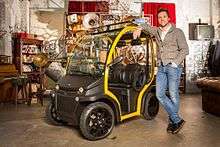Estrima Birò

Birò is a four-wheeled electric vehicle with two seats side by side. It is produced and distributed by Estrima, an Italian company located in Pordenone.
It belongs to the category of electric mopeds, in particular to the light quadricycle one. It is legally comparable to a 50 cc (3.1 cu in) moped: its maximum speed is 45 km/h (28 mph) and, in Italy, it can be driven from the age of 14 with a driver's license.
History
Estrima is a startup company established in Pordenone in 2008 by the will of its president, Matteo Maestri, with the intention of evolving the experience of the family corporation Brieda Srl into new emerging sectors. The aim of Estrima was to reduce the problems regarding urban mobility such as traffic congestion and pollution, creating the smallest four-wheel electric vehicle on the market, Birò. Production of the vehicle started in June 2009, and in 2010 and 2011 Birò was the most registered electric vehicle in Italy among the categories of 2, 3 and 4 wheels. At the end of 2012, Red Circle Investments, the company of the Rosso family, acquired 30% of the shares of Estrima.
Features
Aesthetic
Birò is the smallest four-wheel electric vehicle on the market; it is 1.03 metres (41 in) wide and 1.74 metres (69 in) long. The vehicle has a toughened dark-green extensible roof and rear glass, roomy compartments, headrest and armrest. It is possible also include the kit doors, the radio pre-installation and the external trunk trolley. The structure of Birò is made of 3 mm thick tubular steel and it protects the driver and the passenger. Estrima is the only one company having produced a vehicle with a great transparent surface that is an important aesthetic innovation.
Technical
The very low center of gravity of Birò ensures stability and an appreciated road grip; thanks to the electric engines it has great pickup that can be improved by pulling the “boost” lever. On the Birò it is possible have two different kind of batteries, the pure lead and the lithium battery. Birò is moved by two brushless 48 V electric engines, set up directly in the rear wheels, that produce 4 kW of power. Depending on the type of batteries, Birò can have a range of about 40 or 70 km, varying according to temperature, driving style, travel type and weight.
Consumption
- On low range or urban cycle, with many start-stop process, the Biro uses 78 Wh/km.
- On mid range or combined usage, mixing urban and open driving, this decreases consumption to 64 Wh/km.
- On the maximum range, or extra-urban, with open roads, including hills, provided the "Boost" function is not used it can achieve 55 Wh/km.[1]
On the maximum range, if one has installed a consumption indicator, the Ah consumed is the same as the kilometres travelled (25 Ah = 25 km).
Power
The normal current used by the Birò is a "top" 80 A (restricted and maximal point) with any voltage range from 36 V to 53 V. The "aid" mode current for uphill (20% say by the Estrima builder) named "boost" function can override temporary the current restriction to a top of 130 A (constant and restricted).
- The "boost" function is restricted as the normal current by the temperature sensor on each motor and by the "36v" low alert voltage.
- At 36 V, the Biro controllers restrict the current to "stay at 36v" ... the speed and torque decrease dramatically (it's not a "reserve indicator").
- The "reserve" way of the Biro it's more like you feel a low torque because of the decrease of the voltage of the battery.
On normally, the "in drive" voltage is 48 V (80 A) and 46 V (130 A).
On "reserve" range, the voltage is 45 V (80 A) and 43 V (130 A) so, at that point, one must find a way to quickly reach a point of recharge.
References
- ↑ "Vie et fable d'un Estrima Biro. Forum Cyclurba.fr. Voitures & camions électriques". Cyclurba.fr. Retrieved 2013-10-03.